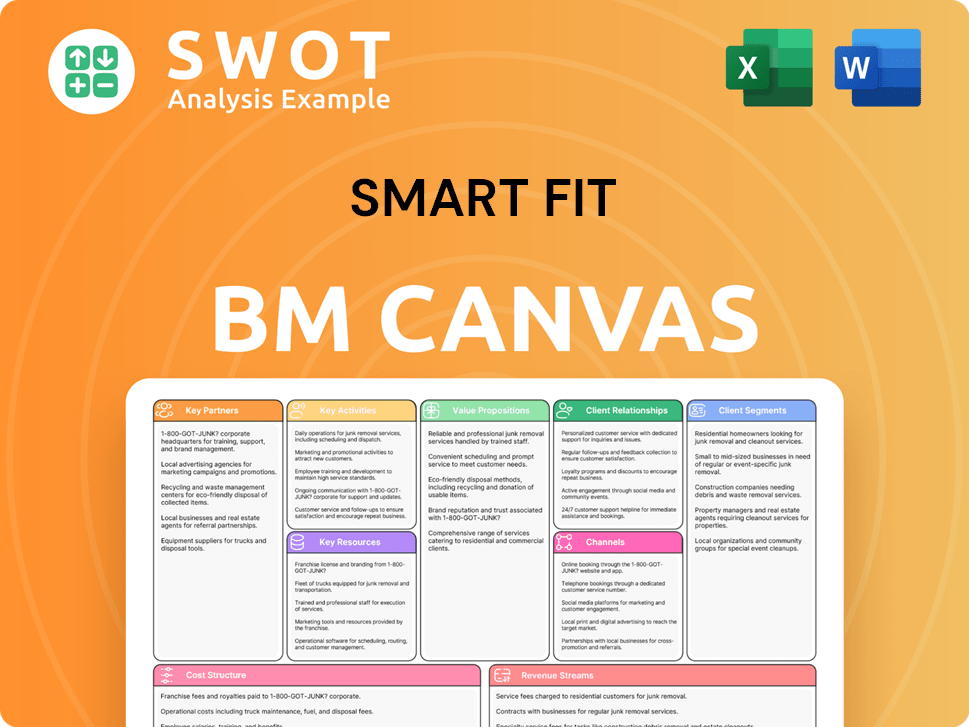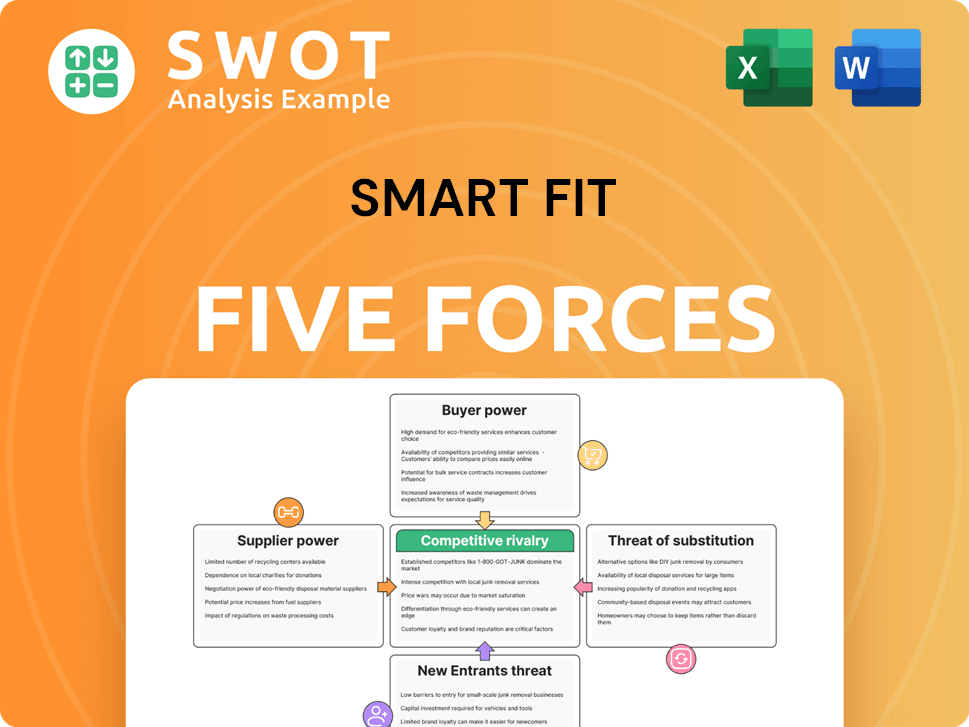Smart Fit Bundle
Can Smart Fit Maintain Its Dominance in the Latin American Fitness Arena?
The Latin American fitness industry is booming, with affordable gym chains leading the charge. Smart Fit, a pioneer in this space, has revolutionized fitness accessibility since its 2009 launch in Brazil. But, how does Smart Fit stack up against its rivals, and what strategies ensure its continued success?

To understand Smart Fit's position, we'll conduct a thorough Smart Fit SWOT Analysis, examining its strengths, weaknesses, opportunities, and threats. This deep dive will explore the Smart Fit competitive landscape, analyzing its Smart Fit competitors, and providing a comprehensive Smart Fit market analysis. We'll also explore fitness industry trends and gym market share to provide a clear fitness center comparison and uncover the keys to its future growth, considering factors like Smart Fit business model analysis and Smart Fit expansion strategy.
Where Does Smart Fit ’ Stand in the Current Market?
The company holds a strong market position in the Latin American fitness industry. This is largely due to its rapid expansion and focus on affordability. As of late 2023, the company operated over 1,300 units across 15 countries, including Brazil, Mexico, Colombia, Chile, and Peru. It served more than 4.2 million clients. This extensive presence and large customer base solidify its leadership in the region's gym sector. Its primary services include access to modern cardio and strength training equipment, along with various group fitness classes and specialized programs, all within a budget-friendly membership model.
The company has consistently targeted the budget-conscious segment. This strategy distinguishes it from higher-priced, more exclusive fitness clubs. This positioning has allowed the company to capture a significant share of the market. It attracts individuals who might otherwise be unable to afford gym memberships. While precise market share figures for 2024-2025 are still emerging, the company's continued expansion and subscriber growth indicate a sustained strong position. In terms of financial health, the company reported net revenue of R$2.8 billion in 2023, a 47% increase compared to 2022, highlighting its robust financial performance relative to industry averages.
The company's strongest positions are in Brazil and Mexico. These countries have the densest network of units and the largest client bases. For a detailed look at the customer base, you can explore the Target Market of Smart Fit .
The company's competitive advantages include its extensive geographic reach and large customer base. Its focus on affordability makes it accessible to a broad demographic. This strategy has allowed it to capture a significant share of the fitness market in Latin America.
The company's financial performance in 2023 was strong, with net revenue reaching R$2.8 billion. This represents a 47% increase compared to 2022. This growth underscores the company's robust financial health and market position within the fitness industry.
The company's primary markets are in Brazil and Mexico. These countries have the highest concentration of units and the largest client bases. The company continues to expand its presence across Latin America.
The company serves over 4.2 million clients across its network of gyms. The budget-friendly membership model attracts a wide range of customers. This includes individuals who might not otherwise be able to afford gym memberships.
The company's market position is characterized by its aggressive expansion strategy and focus on affordability, making it a key player in the fitness center comparison. The company's business model analysis reveals a strong emphasis on providing value through accessible pricing and a wide range of fitness services. The company's expansion strategy has allowed it to capture a significant share of the gym market share.
- Competitive Landscape: The company competes with other gyms by offering affordable membership options.
- Customer Demographics: The company's customer base includes a broad range of individuals seeking budget-friendly fitness solutions.
- Expansion Strategy: The company continues to expand its presence across Latin America, focusing on key markets like Brazil and Mexico.
- Financial Performance: The company's revenue growth demonstrates its strong financial health within the fitness industry.
Smart Fit SWOT Analysis
- Complete SWOT Breakdown
- Fully Customizable
- Editable in Excel & Word
- Professional Formatting
- Investor-Ready Format

Who Are the Main Competitors Challenging Smart Fit ?
The Marketing Strategy of Smart Fit is significantly shaped by the competitive landscape it navigates. The fitness industry in Latin America is dynamic, with various players vying for market share. Understanding the Smart Fit competitive landscape is crucial for assessing its strategic positioning and future growth prospects.
Smart Fit competitors are both direct and indirect. Direct competitors include other large gym chains that focus on similar target markets, while indirect competitors encompass a broader range of fitness solutions, from boutique studios to online platforms. This multifaceted competition necessitates a robust understanding of Smart Fit market analysis to stay ahead.
The fitness industry in Latin America has shown resilience and growth. According to recent reports, the fitness market in Latin America is expected to continue growing, with a projected value of over $5 billion by 2025. This growth is fueled by increasing health awareness and a rising middle class. This expansion provides opportunities for Smart Fit and its competitors.
Direct competitors are gym chains that offer similar services and target the same customer base as Smart Fit. These competitors often compete on price, location, and equipment offerings.
Bio Ritmo, part of the same group as Smart Fit, is a direct competitor. While it targets a slightly different segment, it shares similar operational strategies and geographic presence.
Other national and regional low-cost gym chains pose a significant competitive threat. These gyms often compete on price and convenience, attracting budget-conscious consumers.
Indirect competitors offer alternative fitness solutions that compete for the same consumer spending. These competitors can impact Smart Fit's market share by offering different value propositions.
Boutique studios specializing in classes like CrossFit, yoga, and spinning offer specialized fitness experiences. These studios often attract customers seeking more personalized training.
Online platforms and apps provide virtual workouts and fitness programs. They offer convenience and flexibility, appealing to consumers who prefer at-home workouts.
The fitness industry is subject to mergers, acquisitions, and strategic partnerships. These alliances can reshape the competitive landscape, creating larger and more diversified entities. Understanding these dynamics is essential for assessing Smart Fit's long-term viability. The rise of at-home fitness solutions, particularly accelerated during the pandemic, has also presented a challenge, as consumers increasingly opt for convenient and flexible workout options.
- Pricing Strategies: Competitors often use similar pricing models, creating price-sensitive competition.
- Equipment and Services: The availability of modern equipment and diverse fitness classes is a key differentiator.
- Location and Accessibility: Convenient locations and easy access are crucial for attracting and retaining customers.
- Marketing and Branding: Effective marketing campaigns and brand recognition play a significant role in attracting customers.
Smart Fit PESTLE Analysis
- Covers All 6 PESTLE Categories
- No Research Needed – Save Hours of Work
- Built by Experts, Trusted by Consultants
- Instant Download, Ready to Use
- 100% Editable, Fully Customizable

What Gives Smart Fit a Competitive Edge Over Its Rivals?
Understanding the Brief History of Smart Fit is crucial for assessing its competitive advantages within the dynamic fitness industry. The company's success is built upon a foundation of strategic moves and a keen understanding of market dynamics. This has allowed the company to establish a strong foothold in the competitive landscape.
The company's ability to offer affordable, high-quality fitness services has been a key differentiator. This approach has enabled it to capture a significant share of the gym market. The company has consistently adapted to fitness industry trends, ensuring its offerings remain relevant and appealing to a broad customer base.
The company's competitive edge stems from its operational efficiencies and strategic market positioning. The company has effectively leveraged its resources to maintain a competitive advantage. This has allowed the company to thrive in a competitive environment.
The company's extensive network of gyms enables significant economies of scale. This large-scale operation allows for favorable terms with suppliers and real estate owners. The resulting cost advantages are a major barrier to entry for smaller competitors.
The company has cultivated strong brand equity, particularly in Latin America. This brand recognition translates into customer loyalty and a steady stream of new members. The brand is synonymous with accessible and modern fitness.
The company focuses on customer loyalty through straightforward membership plans and consistent service quality. Its customer-centric approach enhances member experience, leading to higher retention rates. This approach is a key factor in its market success.
The company leverages technology to enhance the member experience, including its proprietary app. This digital integration streamlines operations and provides added value to members. The company's app supports class bookings and workout tracking.
The company's competitive advantages are a blend of scale, brand recognition, and technological integration. These strengths have enabled the company to maintain a strong position in the fitness industry. Continuous innovation is essential to maintain these advantages.
- Economies of Scale: Large gym network and high membership volume.
- Strong Brand: Synonymous with accessible and modern fitness, particularly in Latin America.
- Customer Loyalty: Straightforward membership plans and consistent service quality.
- Technological Integration: Proprietary app for class bookings and workout tracking.
Smart Fit Business Model Canvas
- Complete 9-Block Business Model Canvas
- Effortlessly Communicate Your Business Strategy
- Investor-Ready BMC Format
- 100% Editable and Customizable
- Clear and Structured Layout

What Industry Trends Are Reshaping Smart Fit ’s Competitive Landscape?
The Smart Fit competitive landscape in the Latin American fitness industry is dynamic, shaped by evolving fitness industry trends and the strategic responses of key players. Understanding these trends and the competitive dynamics is crucial for assessing the company's future prospects. The company's ability to adapt to these changes will significantly influence its success in the coming years.
The Smart Fit market analysis reveals a blend of opportunities and challenges. The company faces both external pressures and internal considerations. The company must navigate these complexities to maintain and enhance its position.
The Latin American fitness industry is experiencing growth, driven by increasing health awareness and lifestyle changes. Digitalization is transforming the sector, with online fitness platforms and apps gaining popularity. Demand for affordable and accessible fitness solutions remains strong, which aligns with the company's core business model.
A key challenge is the rise of online fitness platforms and at-home workout options, potentially impacting traditional gym memberships. Economic downturns could affect consumer spending on fitness. Regulatory changes, particularly in health and safety, may increase operational costs.
Opportunities include expanding into underserved markets within Latin America. Further diversification of digital offerings can create a comprehensive fitness ecosystem. Strategic partnerships with health and wellness providers can broaden service offerings.
The Smart Fit competitors include both large international chains and local gyms. The company's value proposition centers on affordability and accessibility, which differentiates it from premium fitness centers. Understanding the gym market share of each competitor is crucial for strategic planning.
The company needs to integrate its physical locations with enhanced digital offerings. This hybrid approach is crucial for retaining and attracting customers. Strategic market analysis is essential for identifying expansion opportunities and addressing competitive threats. To learn more about the company's strategic direction, read about the Growth Strategy of Smart Fit .
- Diversifying service offerings to include premium options or specialized programs can attract a broader customer base.
- Exploring strategic partnerships with health and wellness providers can enhance the overall fitness ecosystem.
- Regularly evaluating and adapting the Smart Fit pricing comparison to maintain competitiveness is crucial.
- Analyzing the Smart Fit customer demographics will help tailor marketing strategies and service offerings.
Smart Fit Porter's Five Forces Analysis
- Covers All 5 Competitive Forces in Detail
- Structured for Consultants, Students, and Founders
- 100% Editable in Microsoft Word & Excel
- Instant Digital Download – Use Immediately
- Compatible with Mac & PC – Fully Unlocked

Related Blogs
- What are Mission Vision & Core Values of Smart Fit Company?
- What is Growth Strategy and Future Prospects of Smart Fit Company?
- How Does Smart Fit Company Work?
- What is Sales and Marketing Strategy of Smart Fit Company?
- What is Brief History of Smart Fit Company?
- Who Owns Smart Fit Company?
- What is Customer Demographics and Target Market of Smart Fit Company?
Disclaimer
All information, articles, and product details provided on this website are for general informational and educational purposes only. We do not claim any ownership over, nor do we intend to infringe upon, any trademarks, copyrights, logos, brand names, or other intellectual property mentioned or depicted on this site. Such intellectual property remains the property of its respective owners, and any references here are made solely for identification or informational purposes, without implying any affiliation, endorsement, or partnership.
We make no representations or warranties, express or implied, regarding the accuracy, completeness, or suitability of any content or products presented. Nothing on this website should be construed as legal, tax, investment, financial, medical, or other professional advice. In addition, no part of this site—including articles or product references—constitutes a solicitation, recommendation, endorsement, advertisement, or offer to buy or sell any securities, franchises, or other financial instruments, particularly in jurisdictions where such activity would be unlawful.
All content is of a general nature and may not address the specific circumstances of any individual or entity. It is not a substitute for professional advice or services. Any actions you take based on the information provided here are strictly at your own risk. You accept full responsibility for any decisions or outcomes arising from your use of this website and agree to release us from any liability in connection with your use of, or reliance upon, the content or products found herein.